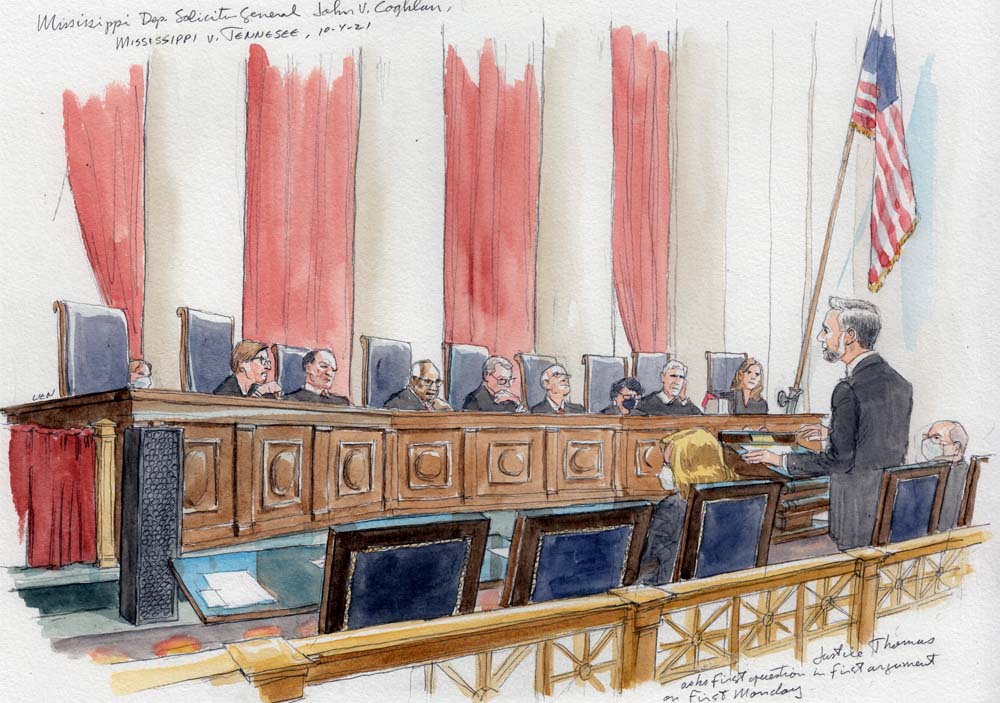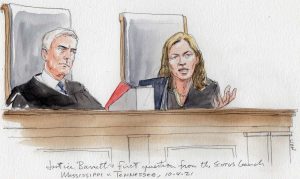A VIEW FROM THE COURTROOM
In-person arguments come out of storage

on Oct 4, 2021 at 6:57 pm

A View from the Courtroom is an inside look at significant oral arguments and opinion announcements unfolding in real time.
After a particularly busy and newsy couple of months for the Supreme Court and its shadow — er, emergency — docket and for some individual justices and their public appearances, the focus shifts back to the regular merits docket today.
Credentialed court reporters are among the few people who will be allowed in the courtroom, so the first stop on returning to the court building is the press room, in time for the 9:30 a.m. order list. That yogurt I left in the mini-fridge back in March 2020 is probably still OK to eat, right?
Telephone arguments allowed listeners to choose a comfy chair at home, have a cup of coffee, and, for the more garden-variety cases, decide between checking one’s email or having TV on low in the background. There was more than one argument over the past 18 months in which my attention wandered to the third hour of the “Today” show, with Hoda Kotb and Jenna Bush Hager. Or, when there was a second case, or the first case ran well past the traditional hour (which was usually), 11 a.m. brought “The View” or that long-running economics-affairs show, “The Price is Right.”
While many advocates and several justices have weighed in on the pros and cons of the telephone format, they did seem just mentally exhausting despite having the creature comforts of home.
Reporters are escorted upstairs and, instead of heading for the press rows of the courtroom, which are to the left of the bench and adjacent to the bar section, we will sit in designated spaces in the public gallery. Also filing into that gallery are the justices’ law clerks and a few other court employees.
The lectern and tables for lawyers arguing cases have been pushed to the back edge of the bar section, which is otherwise devoid of the many chairs where bar members would sit.
In the VIP section, to the right of the bench, Justice Amy Coney Barrett’s husband, Jesse, is seated in the third row of that section. A little later, Art Lien and I notice Barrett’s parents, Michael and Linda Coney, in the front row of the public gallery, near the VIP section.
Justice Stephen Breyer’s wife, Joanna, soon takes her seat in the VIP section. Retired Justice Anthony Kennedy takes a seat, and then Jane Roberts, the wife of Chief Justice John Roberts, enters the section as well.
Barrett, who started hearing cases in the telephone format last November and took the bench for her ceremonial investiture this past Friday, is taking the bench for oral argument for the first time today.
It is almost 40 years to the day since Justice Sandra Day O’Connor took her seat for oral argument for the first time, on Oct. 5, 1981. Chief Justice Warren Burger did not give any special mention of the milestone on that day, but O’Connor had had her investiture just 10 days earlier, when Burger extended “a very warm welcome” to her and wished her “a very long life and happy career in our common calling.” (Linda Greenhouse had a nice remembrance of that investiture in a recent column in The New York Times.)
The recent documentary “Sandra Day O’Connor: The First,” which aired last month on the PBS series “American Experience,” noted that in O’Connor’s first argument, one lawyer interrupted her first question. That sent me to Oyez.org for the recording of the argument in Watt v. Energy Action Educational Foundation.
The transcript on Oyez suggests that the lawyer, John Silard, used a polite “May I just finish the thought?” as O’Connor sought to ask her question. The recording, though, suggests a more brusque verbal stiff-arm of the new justice by the lawyer.
More recently, Chief Justice John Roberts welcomed Barrett to her first telephone argument last Nov. 2 with, “We wish you a long and happy career in our common calling.”
At 10 a.m., the court’s new marshal, Gail Curley, gives the cry of “Oyez! Oyez! Oyez!” Curley came to the court from the U.S. Army, where she was head of the National Security Law division of the Office of the Judge Advocate General. She succeeded Pamela Talkin, who retired July 31 after 19 years as marshal.
When the justices take the bench, all are present except for Justice Brett Kavanaugh, who tested positive for COVID-19 last week and is participating from home quarantine. As with last week’s investiture, the justices are maskless except for Justice Sonia Sotomayor, who will keep her black mask on even when she asks questions.

Justice Kavanaugh’s empty chair. (Art Lien)
The chief justice announces that the October Term 2020 is now closed and that the October 2021 term is now convened. He announces that Kavanaugh will participate in today’s arguments remotely, a first for a courtroom argument. He then welcomes Curley and says “we wish her well in her service as the court’s 11th marshal.”
Roberts does not take any special note of the court’s return to the courtroom or the fact that there is an audience beyond those present, as the court makes the live audio available as it did with telephone arguments since May 2020.
For a term with some blockbuster cases, the court’s return to the bench comes with some garden-variety disputes, but they will provide some notable and amusing moments.
The first case is Mississippi v. Tennessee, from the original docket, a long-running case between the two states over groundwater in the Middle Claiborne Aquifer. Mississippi objects to the withdrawal of water by Memphis’ public utility from the aquifer, but a special master appointed by the court found that the water was not owned by Mississippi but was an interstate water resource subject to “equitable apportionment,” a doctrine more typically involved in river disputes between states.
The argument will also be the first test of the court’s announced hybrid system for oral argument, involving both the usual free-for-all questioning that was missing from the telephone arguments, and one round of seriatim questioning at the end of each arguing attorney’s presentation.
While the seriatim round was widely viewed as a way to keep Justice Clarence Thomas engaged as he was during telephone arguments, it is Thomas who asks the first question of John Coghlan, the deputy solicitor general of Mississippi.
“Well, counsel, you seem to complain about Tennessee pumping water from Mississippi, but you admit that Tennessee does not enter across the border into Mississippi, isn’t that correct?” Thomas says. He asks four follow-up questions.
The rather, ahem, dry argument takes an interesting turn when the chief justice asks a hypothetical question about the “wild horses, or wild burros, whatever they are,” of the Western states that wander across state lines, and whether a state could “exercise dominion” over them. Later, Justice Neil Gorsuch, one of two native Westerners on the bench, asks a question that refers to the chief justice’s “herd of wild burros, who may or may not be a nuisance.”
Breyer, who is a native of San Francisco, refers to that city’s infamous fog and its possible transport or movement across state lines.
“Do you understand how I’m suddenly seeing this and I’m totally at sea?” he tells Coghlan. “It’s that the water runs around. And whose water is it? I don’t know.”
Breyer may be at sea for another reason. For the first time since he joined the court in 1994, he is not seated next to Thomas. With Justice Ruth Bader Ginsburg’s death last year, and the court finally back on the bench, Breyer has moved to the seat on the left of Roberts. That would seem to make it difficult for Breyer and Thomas to lean back in their chairs and have whispered, sidebar conversations during arguments, as they have done for years. But that doesn’t seem to dampen Breyer’s conversational proclivities. He can be seen turning to Sotomayor on his left, and even to Roberts, on his right, for short conversations throughout the morning.

Justice Barrett asks her first question from the bench. (Art Lien)
About 20 minutes into the argument, Barrett asks her first question from the bench, a follow-up to a question to Coghlan from Justice Elena Kagan about why groundwater should be treated differently legally from, say, a river. Coghlan does not interrupt her question.
Through much of today’s two arguments, Barrett leans forward with her elbows on her desk and her hands clasped. She and Gorsuch, on her right, only rarely speak during the two-plus hours. Meanwhile, Kavanaugh chimes in several times by phone. He sounds crystal clear over the speakers in the courtroom, though he does lose a faceoff with Barrett when he tries to ask his first question. At various times when the chief justice calls on the missing justice, he turns and looks at Kavanaugh’s empty seat.
Late in the argument, Roberts tells David Frederick, representing Tennessee, that “I’ve had a little trouble following the science here. Is this really water we’re talking about?”
The chief justice asks about silt and sand. “Someone explained to me it’s like you’re in the side of the shore and you put your foot down and when you lift it up, it kind of fills with water in that gap, right?”
Frederick replies, “That is descriptive of parts of the aquifer, yes.”
“Well, it’s the part that I could understand,” the chief justice responds, which draws laughter from the limited crowd. (By my rough count, there are about 60 people spread throughout the public gallery.)
Roberts suggests that someone looking at a handful of silt from the aquifer would not say, “Oh, that’s water.”
Frederick responds with a bit of a commercial for Memphis drinking water. “Well, Mr. Chief Justice, I think you would say that it is water because it’s some of the finest water that anyone can drink in the United States. This artesian water is absolutely spectacular water that they have pumped and they have run it over filters that filter out some of the iron and some of the other minerals, but it is very pure water and it is delicious.”
In another originaldocket case, Florida v. Georgia in 2018, Breyer sought to liven up the opinion announcement in a decision involving an interstate river basin covering the two states by recommending a couple of songs that evoke, as he put it, “the beauty and the emotional appeal of this southeastern river basin.”
The songs were “Chattahoochee,” by Alan Jackson, and “Apalachicola F.L.A.,” by Bing Crosby and Bob Hope. (The court issued a second decision in the same Florida v. Georgia dispute, in an opinion this past April by Barrett that included no musical references.)
Today’s water dispute between Tennessee and Mississippi comes from a musically fertile region that has given the nation one artist — Elvis Presley — that both states can rightfully claim for their territorial bragging rights. But the Middle Claiborne Aquifer evidently has not inspired any memorable ditties by country or pop artists, so the eventual opinion announcement in this case is likely to be as dry as dust. (But there’s always the Rolling Stones song “Wild Horses.”)
If the first argument started to sound like the TV show “Bill Nye the Science Guy,” the second has shades of “Storage Wars,” the cable show about teams bidding on unclaimed ministorage compartments based on only a quick peek at the contents. Usually the contents amount to the dreck of unfulfilled dreams, but the bidders occasionally score with valuable finds such as a My Little Pony collection, a cache of vintage video games, and a stack of newspapers from when Elvis Presley died.
The question in Wooden v. United States is whether offenses that were committed as part of a single criminal episode, but sequentially in time, were “committed on occasions different from one another” for purposes of a sentencing enhancement under the Armed Career Criminal Act.
The answer is important to petitioner William Dale Wooden, who with some others was convicted in 1997 for breaking and entering and stealing items from 10 ministorage units in Georgia. The burglars had entered one unit and then broke through drywall to reach others. So, their variation on “Storage Wars” was to bid zero dollars and take what they wanted regardless of whether the units had been abandoned or not.
Wooden did not score much from the ministorage thefts. According to court documents, the haul included cassette tapes, an air tank, fishing gear, a typewriter, a Citizen Bands radio amplifier, a weed trimmer, assorted costume jewelry, one silver ring, and tools (lots of tools).
In 2015, Wooden was arrested for gun possession and charged as a felon in possession of firearms and ammunition. The federal government, counting the ministorage burglaries as 10 separate felonies, sought to label Wooden a career criminal under ACCA. His sentence went from a recommendation of 21 to 27 months to the 15-year mandatory minimum (with a sentence of just over that).
As this argument unfolds, it becomes clear that the justices are deferring to Thomas for the first question of the free-for-all round. The chief justice even turns his head to look at him when Wooden’s lawyer, Allon Kedem, ends his introduction. And Thomas only once asks a question during the seriatim rounds, with most justices shaking their heads no during those rounds except for a few questions from Kavanaugh, Gorsuch, and Barrett.
Thomas asks Kedem how much of a break between burglaries might be necessary to classify them as separate “occasions.”
“What if they took a smoke break?” Thomas says. “What if they decided to have lunch? What if they said, look, … we’ve got lots of time; we can go to Starbucks, grab a cup of coffee or something like that.” He then amends that to Dunkin’ Donuts.
Kedem says those might qualify as an intervening event and that “discontinuity where the underlying circumstances has changed” would be required.
Justice Samuel Alito, who didn’t speak during the first argument, says “occasion” is hard to define. What if a streetlight went out and a mugger sees that as an opportunity to rob people at 10 p.m., 11 p.m., and midnight, he wondered.
Kedem said that might be the same opportunity, but doing it on three separate days would likely mean separate occasions.
Roberts asks about moonless nights, and whether the resulting darkness gives the mugger his opportunity. Kedem again says one night would seem to constitute the same opportunity and thus a single occasion. (The chief justice also refers to the “two moonless nights a month.” SCOTUSblog editor and self-described space buff James Romoser points out later that most months, in fact, have only one moonless night.)
Erica Ross, an assistant to the solicitor general, gets a pretty rough time, with Breyer asking about Jesse James going from train car to train car to rob people, “but his cousin Harry James only robbed one car in one train once, but there were four people on it, and then he gave up his life of crime. And you’re saying … not just Jesse but Harry too will spend 15 years in jail extra?”
Ross tries to answer, but as Breyer continues to add to the hypo, she says, “So, I’m not quite sure if I’m following.” And Breyer says, “Forget it. I’m going off too far.”
One more thing becomes evident after these two arguments. The “minute to sum up” that the chief justice offered lawyers at the end of questioning during the telephone arguments was not offered today. The court is edging slowly back to its normal argument routines.


